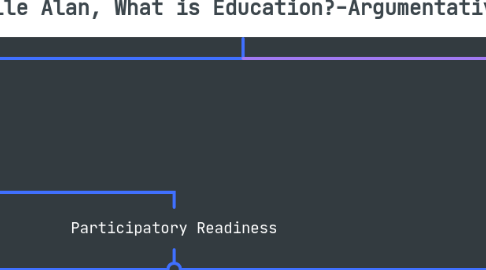
1. Argues that citizenship is is absent from education policy in generall. Schools should focus more on teaching civic qualiteis.
1.1. Fair economic outcomes are aided by robust democratic process and, and therefore by genuine political equality.
1.2. Participatory readiness: reducing inequaity through democratic process and political actions. Promoting equality through schooling.
1.2.1. Schools require more resources
1.2.1.1. Danielle mentions Claudia Goldin, Larry Katz's books, and Rephrases French economist Thomas Piketty.
1.2.1.1.1. "The Principal Mechanism for convergence of income and wealth is the diffusion of Knowledge"-Piketty
1.2.1.1.2. Mentions Piketty argument that educational insitution should be broadly accessible; elite insitutions should draw students from other backgrounds.
1.3. Equality and the Participatory paradigm
1.3.1. Economic inequality is an outgrowth of politics.
1.3.1.1. Rodrik Writes "Today’s world economy is the prod uct of explicit decisions that governments had made in the past,"
1.3.1.1.1. “It was the choice of governments to loosen regulations on finance and aim for full cross-border capital mobility, just as it was a choice to maintain these policies largely intact, despite a massive global financial crisis." Or, as Daron Acemoglu and Jim Robinson argue, "It is the institutions and the political equilibrium of a society that determine how technology evolves, how markets function, and how the gains from various different economic arrange ments are distributed.”
1.3.2. Political choices determine the rules that shape distributive patterns, it makes sesnes to focus first on political, not economic, equality.
1.3.2.1. This leads to empowering people to participate capably in the life of a polity, and provide a different view of education's purpose, contnet and consequences.
1.3.2.1.1. An education that prepares every student for civic and political engagement supports politcal equality, but may lead to increase economic fairness.
1.3.2.2. 2006 why does Democracy needs Education-Edward L. Glaeser, Giacomo Ponzetto, Andrei Shleifer argue that education is a casual force behind democracy.
1.3.2.2.1. Education increases income and particiapation correlates to socieoeconimic status.
1.4. Participatory Readiness
1.4.1. Student should getting prepared for civic agency.
1.4.1.1. Three core task of civic agency
1.4.1.1.1. 1. Disinterested deliberation around a public probelm
1.4.1.1.2. This task can be separated to create different civic roles. Which is the situation today.The role have been divided civic engaged individuals, Activist, and Professional politicians.
1.4.1.1.3. There is also the ordinary citizen who is not a professional politican but has or an activist, but has acquire all 3 compentencies and is proud to be involve in politics.
1.4.1.2. If we are to embrace an education that focuses on participatory readiness we need to focus the schools's curriculum in the idea that civic agency is the activity to co-create a way of life.
1.4.2. Liberal arts/Free person's arts
1.4.2.1. The humanites and social sciences gave us democracy
1.4.2.1.1. European and American colonist created democracy in a continental scale. Danielle uses the Second sentecne of the declaration of independence.
1.4.2.1.2. We hold this truths.....
1.4.3. Philo Hanna Arendt, inspired Danielle to write "I take citizenship to be the activity of co-creating a wayt of life, of World-building"
1.4.3.1. Co creation can occur anywhere where there is a community. Co creation extends beyond legal categories of memberhsip in political units, She prefers to speak civic agency instead of citizenship.
2. Says that the focus in more in vocational education, with the goal to compete in global economy.
2.1. Equality and The Vocational Paradigm
2.1.1. Vocaitional paradigm, was form by the idea that the United States was falling behind in a cold war scientific contest
2.1.1.1. Leading to the National defense Education Act, in 1958.
2.1.1.1.1. The current shape of education and polecies was created due to a national risk during the reagan administration of 1983.
2.1.2. An educated, innovative, motivated workforce-Human Capital- is the most precious resources of any country in this new, flat world
2.1.2.1. There is a concern with the foundation of the Human capital
2.1.2.1.1. 1980 economist saw a connection between education and inequality, hence early 1990s economist identify tecnological change as the primary culprit.
2.2. Connected to tecnocratic economic policy that focuses on the dissetmination to reduce inequality of tecnology dependant economy.
2.2.1. Results increase investment of STEM and reduces focus on humanities coureses.
2.2.2. argues that this is not rhe only possible response to contemporary inequalities.
2.2.2.1. Uses economist Dani Rodrik to point out that economic inequalities
2.2.2.2. Uses Joseph Stiglit's In Rewiritng the rules of The American economy and, states "has been a choice.”Achieving an economy with more egalitarian outcomes will require dif ferent political choices and economic policies. It will require that we choose different rules to govern labor, housing, and financial markets.
